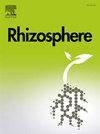Genetic resistance to Fusarium wilt shapes rhizospheric beneficial microbiota in four banana cultivars
IF 3.4
3区 生物学
Q1 PLANT SCIENCES
引用次数: 0
Abstract
This study explores the dynamics of bacterial communities in the bulk soil, rhizosphere, and endosphere of banana plants, focusing on variations among cultivars with differing levels of genetic resistance to Fusarium wilt. Four banana cultivars were examined: one resistant (P), one moderately susceptible (PT), and two susceptible (W and M). Using 16S rDNA sequencing, we analyzed the bacterial community structures in these habitats. Results showed significant differences in bacterial communities across the three habitats and among the cultivars, with the endosphere communities being the most distinct. The rhizosphere and bulk soil communities exhibited more similarities, likely due to the soil microbiome's influence on the rhizosphere. Resistant cultivars (PT and P) displayed unique bacterial communities, with notable taxa such as Burkholderia, Leifsonia, and Marmoricola in the rhizosphere, known for their antagonistic properties against Fusarium oxysporum. Although the most abundant taxa are not the only ones influencing disease suppression, the susceptible cultivars (W and M) were dominated by genera such as Reyranella and Mucilaginibacter, which are yet to be described as potential biocontrol agents against Fusarium wilt. The endosphere of resistant cultivars also featured beneficial genera like Amycolatopsis and Achromobacter, known for their roles in plant growth promotion and disease resistance. The findings underscore the importance of plant genotype and soil type in shaping the rhizosphere microbiome, with specific microbial taxa associated with resistance to Fusarium. These insights suggest a potential for developing targeted microbial-based strategies to enhance disease resistance and overall plant health. The study highlights key microbial players that could be leveraged for biological control and improved management of Fusarium wilt in banana cultivation. This research advances our understanding of plant-microbe interactions and their implications for sustainable agriculture, particularly in combating soilborne pathogens.
四种香蕉栽培品种对镰刀菌枯萎病的遗传抗性塑造了根瘤有益微生物群
本研究探讨了香蕉植株的大块土壤、根瘤层和内气层中细菌群落的动态,重点是对镰刀菌枯萎病具有不同遗传抗性的栽培品种之间的差异。研究了四个香蕉栽培品种:一个抗性品种(P)、一个中度抗性品种(PT)和两个抗性品种(W 和 M)。通过 16S rDNA 测序,我们分析了这些生境中的细菌群落结构。结果显示,三种生境和不同栽培品种之间的细菌群落存在明显差异,其中内圈群落最为明显。根瘤菌圈和块状土壤群落表现出更多的相似性,这可能是由于土壤微生物群对根瘤菌圈的影响。抗性栽培品种(PT 和 P)表现出独特的细菌群落,根瘤菌圈中有 Burkholderia、Leifsonia 和 Marmoricola 等著名类群,它们具有拮抗镰刀菌的特性。虽然最丰富的类群并不是影响病害抑制的唯一类群,但在易感栽培品种(W 和 M)中,Reyranella 和 Mucilaginibacter 等类群占主导地位,这些类群尚未被描述为镰刀菌枯萎病的潜在生物控制剂。抗性栽培品种的内生层中还有一些有益菌属,如 Amycolatopsis 和 Achromobacter,它们在促进植物生长和抗病方面的作用众所周知。这些发现强调了植物基因型和土壤类型在塑造根瘤微生物组方面的重要性,特定的微生物类群与镰刀菌的抗性有关。这些见解表明,有可能开发出基于微生物的针对性策略,以增强植物的抗病性和整体健康。该研究强调了可用于香蕉种植中镰刀菌枯萎病生物防治和改善管理的关键微生物。这项研究加深了我们对植物与微生物相互作用及其对可持续农业的影响的理解,尤其是在防治土传病原体方面。
本文章由计算机程序翻译,如有差异,请以英文原文为准。
求助全文
约1分钟内获得全文
求助全文
来源期刊

Rhizosphere
Agricultural and Biological Sciences-Agronomy and Crop Science
CiteScore
5.70
自引率
8.10%
发文量
155
审稿时长
29 days
期刊介绍:
Rhizosphere aims to advance the frontier of our understanding of plant-soil interactions. Rhizosphere is a multidisciplinary journal that publishes research on the interactions between plant roots, soil organisms, nutrients, and water. Except carbon fixation by photosynthesis, plants obtain all other elements primarily from soil through roots.
We are beginning to understand how communications at the rhizosphere, with soil organisms and other plant species, affect root exudates and nutrient uptake. This rapidly evolving subject utilizes molecular biology and genomic tools, food web or community structure manipulations, high performance liquid chromatography, isotopic analysis, diverse spectroscopic analytics, tomography and other microscopy, complex statistical and modeling tools.
 求助内容:
求助内容: 应助结果提醒方式:
应助结果提醒方式:


